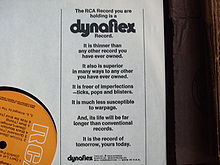- Dynaflex (RCA)
-
Dynaflex was a type of vinyl LP album record pressing introduced by RCA Records in late 1969. Rather than using the stiff plastic material used by conventional vinyl pressings, Dynaflex records used a "flexible" formulation that allowed RCA to use less material, saving money and also making the record appear to lie flatter on turntables. At the time, many industry record pressing plants were using "reground" vinyl, taking old records, removing their paper labels, then melting them down and reusing the plastic components to make new records. Such "reground" vinyl records typically sounded much noisier than a record made from "virgin" vinyl; collectors noted that "reground" records sometimes had small remnants of paper embedded in the outer edge of the LP.
Dynaflex records were flexible enough that they literally "flopped" back and forth when held in the hand. Their flexibility also gave them theoretically more resiliancy in shipping, resulting in fewer returns from retailers due to breakage and cracks. But critics charged that Dynaflex was little more than a smokescreen to allow RCA to employ less vinyl material than in a traditional, thicker pressing.
Opinions from record collectors and audiophiles are divided as to Dynaflex's sound quality. Some felt that the sound quality actually improved, due to better processes for removing impurities in the vinyl compounds; others felt that Dynaflex pressings were both noisier and lacked bass frequencies compared to conventional records, and also had more "rumble" (low frequency noise) than conventional thick pressings. While RCA claimed that Dynaflex records would not warp as much as conventional vinyl records because of their flexibility, some record fans (particularly classical listeners) derided the new technique, calling it 'Dynawarp' because of evidence that Dynaflex records were prone to warp on dealers' shelves, just from the pressure of the shrinkwrap on the album jacket.
RCA eventually discontinued Dynaflex around 1980.
Note that Dynaflex is a completely different system from RCA's Dynagroove, which introduced a predefined amount of distortion during the record-cutting process, to cancel out the distortion produced by conical playback styli, used on most playback cartridges in the early 1960s. This technique was known as tracing compensation, and was made obsolete by the introduction of elliptical playback styli for most good quality phono cartridges by about 1970. Dynagroove also involved tonal manipulation of the recorded sound via a dynamic equalizer.
External links
- Dynaflex defined at the Record Collectors Guild website
- History of Recording Technology
- History of the RCA Record Label design
Categories:- Audio storage
- RCA Records
Wikimedia Foundation. 2010.

